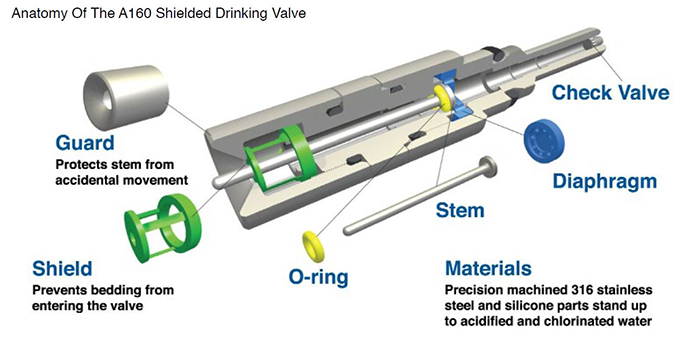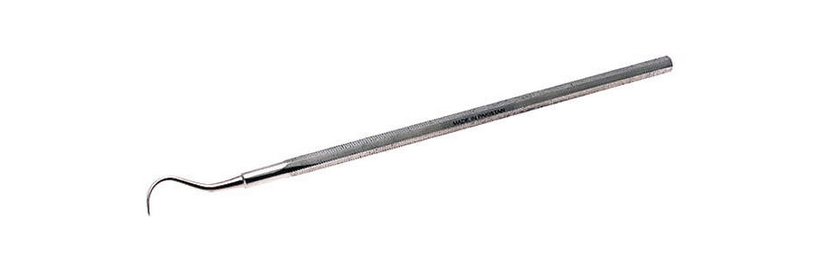Learning to Use Automated Watering Systems
Several rodent suppliers prefer water bottles for their watering systems. The advantage of the water bottle is the sipper tube always has a drop of water on the tip, easily located by young rats and mice. When rodents are shipped to a customer, the purchaser's housing system may include automated watering rather than water bottles and it can sometimes be difficult for young rodents to learn to use the drinking valve.Certain genetically modified animals and animals that have been experimentally manipulated, may be yet slower to learn, or find using automated watering valves (sometimes called "Lixits") difficult, due to lack of vigor, weakness, or cognitive impairment.
Modern drinking valves are very safe and effective. "Animals simply bite, lick, or nose the stem of the valve and water flows out at a controlled rate appropriate for the species. When the animals release the stem, water flow immediately stops1." In most situations, a drop of water remains on the tip of the valve, so rodents can easily locate, activate, and use the valve to obtain water. However, on occasion, the valve can dry out or the animals may fail to acclimate. In this case, they may become dehydrated or even die.
This situation represents both unethical treatment of research animals and a threat to the integrity of any subsequent research. Dehydration may very well affect the physiological responses of surviving animals, altering the endpoints of some experiments and spoiling your results.

Edstrom Industries (Avidity Science) Automated Watering Drinking Valve1
Acclimating to New Systems
Here are some ways to ensure rodents acclimate to your automated watering valves:- Toggling, or activation of the watering valve on a daily basis, can ensure there is a droplet of water on the valve to attract the rodents. As a general practice, all lixits should be toggled when setting up new cages to ensure the valves are operational. Activation can be accomplished manually by pushing directly back on the stem. On some automated watering systems, a needle probe can be used to toggle lixit from the back of the cage. This minimizes disruption to the cage and animals. To prevent contamination between cages, it is recommended fingers/hands and the probe be disinfected between cages. A plastic "toggle" notification marker can be placed on the cage card to remind animal care staff when newly arrived animals need to have their lixits toggled.

Needle probe2
- Slightly leaky training valves are sometimes used to ensure the animals recognize the watering valve as the source of water.
- Temporarily providing a water bottle in addition to automated watering can help ensure animals have access to water while they become acclimated to the new watering system. A Hydropac®3 or similar disposable water source may also be used. (Verify animals are using the drinking valve before removing the backup water source.)
- Adding HydroGel®4 or a similar water gel as a backup to the automated watering system during acclimation to your facility is a good practice to protect valuable research animals. HydroGel® is a non-wetting sterile water gel for animal hydration. It is 98% pure water, sterile inside and out, and gamma irradiated to assure product integrity.
- HydroGel® is particularly useful for animal transportation, as it is clean, dry, and single use. It is also effective at supplementing compromised, weaning or recovering animals and serves well to transition animals to an automated watering system4." However, as with any backup moisture source, it should be verified animals are using the drinking valve before you stop providing it or the gel dries out.
- The Guide for the Care and Use of Laboratory Animals states the following: "Watering devices, such as drinking tubes and automated water delivery systems, should be checked frequently to ensure appropriate maintenance, cleanliness, and operation. Animals sometimes have to be trained to use automated watering devices and should be observed regularly until usage has been established to prevent dehydration5." It is important to check water access and animal condition on a daily basis while they are acclimating to the automated watering system.
- You can sometimes draw the rodents to the valve by adding an attractant to the activation stem. HydroGel® or an alternative attractant can be used. While licking the attractant, the valve will activate and supply water. The rodents will then learn to associate the valve with water. Note: Generally, it is not advised to use a compound with an odor, as this is likely to affect behavior and may impact research results. Caution should also be exercised to ensure the gel or other sticky material does not build up on the lixit and clog it.















.jpg)

.jpg)
.jpg)
.jpg)
.jpg)





.jpg)


.jpg)
.jpg)

.jpg)


.jpg)





.jpg)

.jpg)



